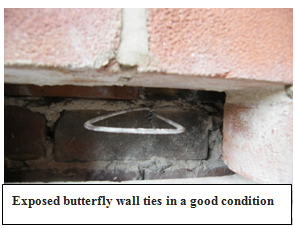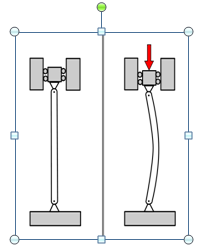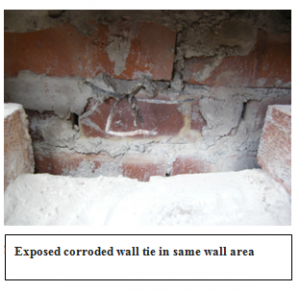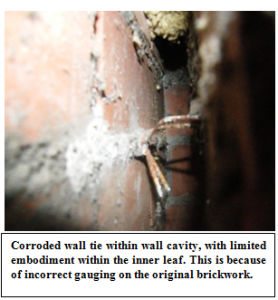What Are Wall Ties?
The answer is most probably yes! If your house constructed of brick or stone, built after the First World War, you probably have cavity wall ties, installed within the construction.
There are two parts to the cavity wall, inner skin and outer skin brickwork normally referred to the inner leaf and the external leaf. Wall ties are an extremely important factor of the wall construction, due to the relative thickness of the outer skin, in relation to its height of the wall. This ratio between the thickness of a wall and its height is known as the ‘slenderness ratio’. Structural engineers calculate this by finding the walls ‘radius of gyration’.

I have tried to explain this in layman’s terms below.

If a wall is 112mm thick (the rough thickness of a standard brick), and is 1 meter tall it would have a slenderness ratio of 1:9 – the wall is nine times taller than its thickness, or the thickness is a 9th of the height (both mean the same thing).
So an average house wall of say 5 meters high has a slenderness ration of about 1:45. That is a very high slenderness ratio, which means that a wall built that high and so thin, without support could be pushed over by a gust of wind or a child’s hand or distorted by the weight applied from above. Alternatively think about in this way, if you construct a column using, Lego of a single brick has the column grows, it becomes very unstable due to the increasing slenderness ration, and is easily pushed over, or bent when pressure is applied.
So let’s apply this theory to the construction of a cavity walls and it’s why wall ties are so important
 As already mentioned a cavity wall is normally constructed of two skins, the inner skin, can be constructed of a similar material, usually brick or block work, but also possibly in some cases timber. It too would have the same slenderness ratio, if it were independent like the outer skin. But, the inner skin benefits from lots of support, which cancels out the slenderness and makes it rigid. These include, the floors, ceiling and wall constructions within the property, which brace it, the roof too, dependent of the type of construction can be and is used, to securely strap the upper areas by means of the wall plate, these points all provide horizontal support.
As already mentioned a cavity wall is normally constructed of two skins, the inner skin, can be constructed of a similar material, usually brick or block work, but also possibly in some cases timber. It too would have the same slenderness ratio, if it were independent like the outer skin. But, the inner skin benefits from lots of support, which cancels out the slenderness and makes it rigid. These include, the floors, ceiling and wall constructions within the property, which brace it, the roof too, dependent of the type of construction can be and is used, to securely strap the upper areas by means of the wall plate, these points all provide horizontal support.
Wall ties provide the lateral support and stability for the outer skin. Spaced at regular intervals horizontally and vertically, the cavity wall ties are braces which are fixed within the mortar beds of both the internal and external leafs of the walls when the walls are originally constructed. The wall ties, provide stability for the outer leaf by providing fixed points back to the inner supported leaf. In effect the outer leaf when correctly tied, forms part of the overall thickness of the wall, reducing the total slenderness ratio significantly.
So what is wall tie failure and what causes it.
Wall Tie Corrosion is the huge legacy, left over from decades of building cavity walls using wall ties made from mild steel these being finished with paint or a zinc coating for protection, from corrosion.
 This mortar was made using a low cost by-product from power stations and used quite widely within the construction of properties, until it was realised that it was a highly corrosive medium in which to bed mild steel wall ties, even if they were galvanised. This mortar was found to be very porous due to its hygroscopic nature (absorbing moisture from the atmosphere) and as such accelerated the corrosion of the wall ties.
This mortar was made using a low cost by-product from power stations and used quite widely within the construction of properties, until it was realised that it was a highly corrosive medium in which to bed mild steel wall ties, even if they were galvanised. This mortar was found to be very porous due to its hygroscopic nature (absorbing moisture from the atmosphere) and as such accelerated the corrosion of the wall ties.
The solution to wall tie failure
Olympic Construction has been undertaking, wall tie replacement and structural stabilisation works, due to the effects of wall tie failure for over three generations, and we have the support of a number of structural engineers who specialise in these areas should we require further technical advice.
Wall Ties & Cavity Wall Tie Replacements in Stockport, Manchester & Cheshire.
If you have any questions please call us on 0161 633 9860 and we will be happy to answer any of your questions or make arrangements to undertaken an inspection, of your wall ties to ensure your property is structurally sound.
www.olympic-construction.co.uk


